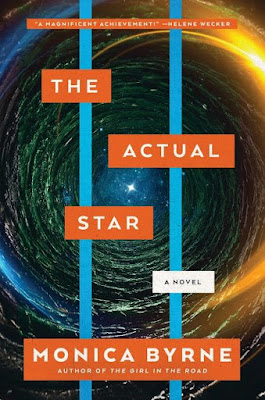Today, I'm celebrating the release of Monica Byrne’s novel, The Actual Star. Before I share my review, I have to admit I’m a bit biased. Novelist, playwright, activist, and futurist Monica Byrne is a dear friend. A year ahead of me at our small Catholic high school in central Pennsylvania, she was essentially the person I wanted to be when I grew up.
For several years, I've been a supporter of Monica's work through Patreon. Rather than simply buying a book after it’s published, patrons send a small amount of money each month to support the author directly at every stage of project development. In return, we get a behind-the-scenes look at the entire creative process.
When Monica was writing about a society in the distant future, she wanted groups who are often ignored or excluded today to be more accurately represented tomorrow. I was one of many expert readers she hired for that purpose.
I’ll say more about my work as a disability consultant in future posts, but I have Monica to thank for introducing me to the profession. The only thing I enjoyed more than consulting on part of her manuscript was getting to read the final product.
Harper Voyager describes The Actual Star as "David Mitchell’s Cloud Atlas meets Octavia Butler’s Earthseed series." Like Butler's Parable of the Sower, this novel explores how healing a broken world requires a new spiritual paradigm. Like Mitchell's book, the story takes place in different time periods that form an interwoven narrative. However, the scope of Monica's work is perhaps broader than both.
In the year 1012, we meet twins Ajul and Ixul and their younger sister Ket, heirs to the throne of the Mayan city-state of Tzoyna in present-day Belize. The court prepares a human sacrifice in the sacred cave of Actun Tunichil Muknal, but an uprising interrupts the coronation ritual.
The collapse of their civilization causes the three siblings' souls to reincarnate as different characters, all of whom face similar struggles in their own times.
In 2012, Minnesota-born Leah Oliveri travels to Belize to explore her Mayan heritage. She meets twin brothers and tourist guides Xander and Javier, and what they discover in the ancient caverns will not only change their lives but will alter the entire course of history.
In 3012, the legend of Saint Leah and the Consort Twins has spawned Laviaja (LA vee AH ha), a worldwide religion that has helped humanity survive the effects of climate change. Niloux and Tanaaj, twins separated at birth, find themselves on opposing sides of a debate that calls their entire belief system into question and threatens all that they hold dear.
The Actual Star has many features I generally like in fiction. The author combines meticulous historical and scientific research with her personal experience as a traveler. Her robust worldbuilding rivals that of J R R Tolkien and C S Lewis, but she centers indigenous cultures and people of color. Characters in every time period challenge gender norms and conventional views of sexuality, relationships, and family.
Monica credits Frank Herbert, Kim Stanley Robinson, Ursula K Le Guin, and many other writers for the social and technological innovations she borrows, but her synthesis of nomadic cultures, gift economies, documented anarchy, artificial intelligence, and need- and skill-based algorithms is very much her own.
The author also uses certain tropes I normally dislike in fiction but didn’t dislike in this novel. I tend to steer clear of religious content that reminds me too much of the Catholicism of my youth, but I was genuinely intrigued by Monica's combination of Catholic saints and sacraments with Mayan concepts of reincarnation and the underworld.
I'm usually turned off by astrology, fortune tellers, prophecies, and vision quests, but I easily accepted Laviaja's use of divination, altered states of consciousness, and fictive techniques as tools to facilitate learning and reduce information overload.
Monica recognizes the limitations of science without abandoning it and acknowledges the power of myth and ritual without treating them as infallible. Even the most uncomfortable material is safe in her hands.
While dystopian fiction is popular, it’s fundamental flaw is the failure to acknowledge that the dystopia is here and now. Every post-apocalyptic hellscape we imagine is, or has been, reality for the enslaved, the colonized, the impoverished, the disenfranchised, and the disabled. What is harder to imagine is a way out, a way forward.
The world of 3012 is far from perfect, but the author shows us a way out of capitalism, nationalism, and white supremacy, a world without borders, partisan politics, or corporate conglomerates.
Laviaja has its problems, but it presents a path through an age of climate catastrophe and displacement, a way to adapt to harsh conditions and use technology to help make life better for everyone instead of making a handful of people rich. The Actual Star demonstrates what is truly possible even if it takes 1,000 years to make it happen.
If you’d like to join me in celebrating this book, here are some suggestions from the author herself.
1. Order The Actual Star from your local independent bookstore. If you prefer audiobook, you can order it through Libro.fm.
2. If your local indie isn’t an option, order from any of the retailers on the official page. You can also order the audiobook through Audible.
3. Request The Actual Star at your local library.
4. Leave reviews on Amazon, Goodreads, and/or StoryGraph.
5. Suggest it for your book club. Better yet, invite the author to join you. To schedule a Zoom session, email monica@monicabyrne.org.
6. If you're a journalist, pitch a review or profile. To request a review copy, email Emily.Fisher@harpercollins.com.
7. Post about it on Facebook, Twitter, Instagram, Tiktok, etc. Tag @Monica Byrne so she can repost.

I love that you've had the opportunity to do disability consulting, and hope you get more chances in the future because I know you have so much to offer in that space!!
ReplyDeleteThanks!
Delete